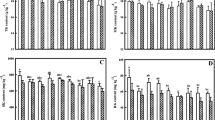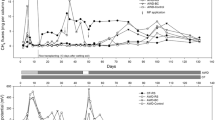Abstract
In a field study, potassium (K) applied as muriate of potash (MOP) significantly reduced methane (CH4) emission from a flooded alluvial soil planted to rice. Cumulative emission was highest in control plots (125.34 kg CH4 ha−1), while the lowest emission was recorded in field plots receiving 30 kg K ha−1 (63.81 kg CH4 ha−1), with a 49% reduction in CH4 emission. Potassium application prevented a drop in the redox potential and reduced the contents of active reducing substances and Fe2+ content in the rhizosphere soil. Potassium amendment also inhibited methanogenic bacteria and stimulated methanotrophic bacterial population. Results suggest that, apart form producing higher plant biomass (both above- and underground) and grain yield, K amendment can effectively reduce CH4 emission from flooded soil and could be developed into an effective mitigation option, especially in K-deficient soils.

Similar content being viewed by others
References
Adhya TK, Rath AK, Gupta PK, Rao VR, Das SN, Parida K, Parashar DC, Sethunathan N (1994) Methane emission from flooded rice paddy fields under irrigated condition. Biol Fertil Soils 18:245–248
Adhya TK, Pattanaik P, Sathpathy SN, Kumaraswamy S, Sethunathan N (1997) Influence of phosphorus application on methane emission and production in flooded paddy soils. Soil Biol Biochem 30:177–181
Anastasi C, Dowding M, Simpson VJ (1992) Future CH4 emissions from rice production. J Geophys Res 97:7521–7525
Ando T, Yoshida S, Nishiyama I (1983) Nature of oxidizing power of rice roots. Plant Soil 72:57–71
Bharati K, Mohanty SR, Singh DP, Rao VR, Adhya TK (2000) Influence of incorporation or dual cropping of Azolla on methane emission from a flooded alluvial soil planted to rice in eastern India. Agric Ecosyst Environ 79:73–83
Bosse U, Frenzel P (1998) Methane emissions from rice microcosms : the balance of production, accumulation and oxidation. Biogeochem 41:199–214
Chen J, Xuan J, Du C, Xie J (1997) Effect of potassium nutrition of rice on rhizosphere redox status. Plant Soil 188:131–137
Chiang CT, Yang CT (1969) Roles of nitrogen, phosphorus and potassium in the metabolism of flooded paddy soils. Taiwan Fest Co Ltd Res Bull 34:54–61
Cicerone RJ Oremland RS (1988) Biogeochemical aspects of atmospheric methane. Global Biogeochem Cycles 2:299–327
Conrad R, Klose M, Claus P (2000) Phosphate inhibits acetotrophic methanogenesis on rice roots. Appl Environ Microbiol 66:828–833
Crutzen P, Lelieveld J (2001) Human impacts on atmospheric chemistry. Annu Rev Earth Planet Sciences 29:17–45
Dlugokencky E (2001) NOAA CMDL Carbon cycle greenhouse gases, global average atmospheric methane mixing ratios. NOAA CMDL cooperative air sampling network. http://www.cmdl.noaa.gov/ccg/figures/chtrend.global.gif
Dobermann A, Cassman KG, Mamaril CP, Sheehy JE (1998) Management of phosphorus, potassium and sulfur in intensive, irrigated lowland rice. Field Crops Res 56:113–118
Graham DW, Korich DG, Leblanc RP, Sinclair NA, Arnold RG (1992) Application of colorimetric plate assay for soluble methane monooxygenase activity. Appl Environ Microbiol 58:2231–2236
Hou AX, Chen GX, Wang ZP, Van Cleemput O, Patrick WH Jr (2000) Methane and nitrous oxide emission from a rice field in relation to soil redox and microbiological processes. Soil Sci Soc Am J 64:2180–2186
IRRI [International Rice Research Institute] (1999) Sustaining food security beyond the year 2000—a global partnership for rice research: medium-term plan 2000–2002. International Rice Research Institute, Los Baños, Philippines
Kaspar HF, Tiedje JM (1982) Anaerobic bacteria and processes. In: Page AL, Miller RM, Keeney R (eds) Methods of soil analysis, Part 2. American Society of Agronomy, Madison, pp 989–1009
Kirk GJD, Bajita JB (1995) Root induced iron oxidation, pH change and zinc solubilization in the rhizosphere of low land rice. New Phytol 131:129–137
Koyama T, Kimura M (1998) Inhibition of methane production in paddy soils. Soil Sci Plant Nutr 44:667–674
Kruger M, Frenzel P (2003) Effects of N-fertilisation on CH4 oxidation and production, and consequences for CH4 emissions from microcosms and rice fields. Glob Chang Biol 9:773–784
Kruger M, Frenzel P, Conrad R (2001) Microbial processes influencing methane emission from rice fields. Glob Chang Biol 7:49–63
Leisack W, Schnell S, Revsbech NP (2000) Microbiology of flooded rice paddies. FEMS Microbiol Rev 24:625–645
Lindau CW (1994) Methane emission from Louisiana rice fields amended with nitrogen fertilizers. Soil Biol Biochem 26:353–359
Lindau CW, Bollich PK, Delaune RD, Patrick WH Jr, Law VJ (1991) Effect of urea fertilizer and environmental factors on CH4 emissions from a Louisiana, USA rice field. Plant Soil 136:195–203
Liou RM, Huang SN, Lin CE (2003) Methane emission from fields with differences in nitrogen fertilizers and rice varieties in Taiwan paddy soils. Chemosphere 50:237–246
Lu Y, Wassmann R, Neue HU, Huang C (1999) Impact of phosphorus supply on root exudation, arenchyma formation and methane emission of rice plants. Biogeochemistry 47:203–218
Masscheleyn PH, DeLaune RD, Pattrick WH Jr (1993) Methane and nitrous oxide emissions from laboratory measurements of rice soil suspensions: effect of soil oxidation reduction status. Chemosphere 26:251–260
Mishra S, Pattnaik P, Sethunathan N, Adhya TK (2003) Anion-mediated salinity affecting methane production in a flooded alluvial soil. Geomicrobiol J 20:579–586
Mishra S, Rath AK, Adhya TK, Rao VR, Sethunathan N (1997) Effect of continuous and alternate water regimes on methane efflux from rice under greenhouse conditions. Biol Fertil Soils 24:399–405
Mosier AR, Duxbury JM, Freney JR, Heinemeyer O, Minami K, Johnson DE (1998) Mitigating agricultural emissions of methane. Climatic Change 40:39–80
Neue HU (1997) Fluxes of methane from rice fields and potential for mitigation. Soil Use Manage. 13:258–267
Ota Y (1970) Diagonostic method for measurement of root activity in rice plant. Jpn Agric Res Q 5:1–6
Padmaja PC (1975) Studies on potassium in rice (Oryza sativa) and rice soils. Ph.D. thesis, Orissa University of Agriculture and Technology, Bhubaneswar, India
Pal SS, Barik S, Sethunathan N (1979) Effects of benomyl on iron and manganese reduction and redox potential in flooded soil. J Soil Sci 30:155–159
Ponnamperuma FN (1972) The chemistry of submerged soils. Adv Agron 24:29–96
Rand MC, Greenberg AE, Taras MJ, Franson MA (1975) Standard methods for the examination of water and waste water. American Public Health Association, Washington
Saleque MA, Kirk GJD (1995) Root induced solubilization of phosphate in the rhizosphere of lowland rice. New Phytol 129:325–336
Sass RL, Fisher FM, Harcombe PA, Turner FT (1990) Methane production and emission in Texas rice fields. Glob Biogeochem Cycles 4:47–68
Satpathy SN, Rath AK, Ramakrishnan B, Rao VR, Adhya TK, Sethunathan N (1997) Diurnal variation in methane efflux at different growth stages of tropical rice. Plant Soil 195:267–27
Satpathy SN, Mishra S, Adhya TK, Ramakrishnan B, Rao VR, Sethunathan N (1998) Cultivar variation in methane efflux from tropical rice. Plant Soil 202:223–229
Sethunathan N, Rao VR, Adhya TK, Raghu K (1983) Microbiology of rice soils. CRC Crit Rev Microbiol 10:125–172
Takai Y, Kamura T (1966) The mechanism of reduction in water logged paddy soils. Folia Microbiol 11:304–313
Tanaka A, Tadano T (1972) Potassium in relation to toxicity of the rice plant. Potash Review Subject 9, 21st suite, pp 1–12
Trolldenier G (1973) Secondary effects of potassium and nitrogen nutrition of rice. Change in microbial activity and iron reduction in the rhizosphere. Plant Soil 38:267–279
Trolldenier G (1977) Mineral nutrition and reduction processes in the rhizosphere of rice. Plant Soil 47:193–202
Vance ED, Brookes PC, Jenkinson DS (1987) An extraction method for measuring soil microbial biomass. Soil Biol Biochem 19:703–707
Wang ZP, Delaune RD, Masscheleyn PH, Patrick WH Jr (1993) Soil redox and pH effect on methane production in a flooded rice soil. Soil Sci Soc Am J 57:382–385
Wang ZP, Lindau CW, Delaune RD, Patrick WH Jr (1992) Methane production from anaerobic soil amended with rice straw and nitrogen fertilizers. Fertil Res 33:115–121
Yagi K (1997) Methane emissions from paddy fields. Bull Natl Inst Agroenviron Sci 14:96–210
Yagi K, Minami K (1990) Effect of organic matter application on methane emission from some Japanese paddy fields. Soil Sci Plant Nutr 36:599–610
Acknowledgement
This work was supported, in part by the National Agricultural Technology Project entitled, “Greenhouse Gas Emission from Rice-based Cropping systems” (Grant No. 26(4)/97-NATP) by the Indian Council of Agricultural research, New Delhi. We thank the Director, Central Rice Research Institute, Cuttack, for permission to publish this work.
Author information
Authors and Affiliations
Corresponding author
Rights and permissions
About this article
Cite this article
Jagadeesh Babu, Y., Nayak, D.R. & Adhya, T.K. Potassium application reduces methane emission from a flooded field planted to rice. Biol Fertil Soils 42, 532–541 (2006). https://doi.org/10.1007/s00374-005-0048-3
Received:
Revised:
Accepted:
Published:
Issue Date:
DOI: https://doi.org/10.1007/s00374-005-0048-3




